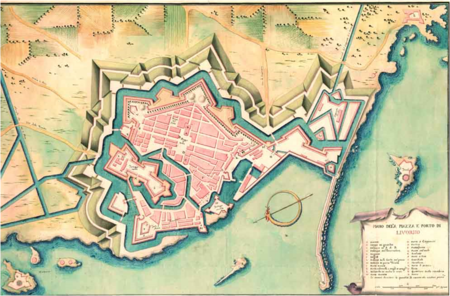MRP: Livorno
Livorno
Editorial history
02/12/11, CSG: Created page
05/12/11, CSG: Uploaded images
27/12/11, CSG: Added hypertext Table of Contents
Contents
Suggested links
Cadiz
Genoa
Malaga
Naples
Messina
Images
Map
Insert Map of situation
Townplan
Insert Town plan
Townscape
Insert Townscape
Image credits & copyright information
Add Image credits & copyright information
(1) Livorno citadel, unknown artist, C17th (Wikimedia, out of copyright)
(2) 'Plan du Port et Rade de Livourne', Jacques Ayrouard (Marseilles, 1732-46), 28.5 x 44.3 cm, uncoloured, copper engraving; from ac chart book by Jacques Ayrouard, Recueil de plusieurs Ports .. de la Mer Méditerranée[1]
Town profile
Livorno, 1670: Richard Lassels, A Voyage of Italy
"[Ligorn] From Pisa we went to Ligorn (Portus Liburnus in Latin) through a pleasant Forrest. This is the onely haven the Great Duke hath; and the mouth which letteth in that food which fatteneth this State. We stayed not long here, the season pressing us to be gone, and this town being soon seen. For the town its but little, yet one of the neatest haven towns a man can see. Heretofore it was not sufferable by reason of the bad air, but since Ferdinand the first built it anew, and dryed up the neighboring Fens (gathering much of the water into a cut channel, which goes from hence to Pisa, and carryes great boats) the Town is twice as wholesome, and thrice as rich as it was.
The things I saw in this Town were these. I. The Mole which shuts up the haven. 2. The Lantern which with seven lights guides in ships in the night. 3. The Haven itself where ships lye safe, and the little haven within that, which serves for a withdarwing room to the great haven, where the Gallys retire themselves. 4. The statue of Ferdinand the first in marble, with the Statues in bronze of four slaves at his feet. These are the 4 slaves that would have stoln away a galley and have rowed here themselves alone; but were taken in their great enterprize. 5. The Greek Church. 6. The Castle. 7. The tower in the Sea where they keep gunpowder. 8. The Jews Synagogue. 9. Two windmills which are rare things in Italy, and therefore must have a place here among the rarities of this town.
I found not any Academy of wits here, nor any records of any learned men of this town. All the Latin here is onely Meum and TXXX and their wits are exercised here how to make good bargains, not good books. Indeed what should the Muses do here amongst the horrible noise of chains, of Carts, of balling Sea-men, of clamorous Porters, and where the Slaves of Barbary are able to fright all learning out of the Town with their looks, as all Latin with their Language. Yet I must congess, they study here belle Lettere: for, if the true belle Lettere be Letters of Exchange, your Marchant here, if you present him a Letter of Exchange from his Corresponden, will read it over, and over again, and study upon it, before he give you the Contents of it in Mony."
(Richard Lassels, A Voyage of Italy)[2]
Notes
Suggested image sources
Suggested primary sources
Richard Lassels, The Voyage Of Italy, Or A Compleat Journey through Italy: In Two Parts : With the Characters of the People, and the Description of the Chief Towns, Churches, Monasteries, Tombs, Libraries, Pallaces, Villa's, Gardens, Pictures, Statues, and Antiquities. As Also of the Interest, vol. 1 (Paris, 1670)
- Bologna, p. 141
- Genua, p. 82
- Ligorne, p. 232
- Lyons, p. 32
- Marseiles, p. 42
- Pisa, p. 228
- Roanne, p. 32
Suggested secondary sources
- ↑ Reproduced with thanks from website of Paulus Swaen, http://www.swaen.com/item.php?id=9034, viewed 20/12/11
- ↑ Richard Lassels, The Voyage Of Italy, Or A Compleat Journey through Italy: In Two Parts : With the Characters of the People, and the Description of the Chief Towns, Churches, Monasteries, Tombs, Libraries, Pallaces, Villa's, Gardens, Pictures, Statues, and Antiquities. As Also of the Interest, vol. 1 (Paris, 1670), pp. 232-234, http://books.google.co.uk/books?id=65FCAAAAcAAJ&printsec=frontcover#v=onepage&q&f=false, viewed 05/12/11]
